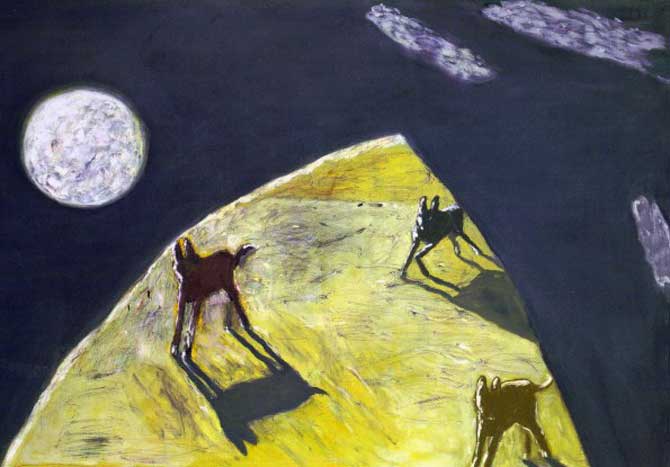Mountains and Rivers Without End is admirably ambitious. As the jacket notes, it was “Initially inspired by East Asian landscape painting and his [Snyder’s] own experience within ‘a chaotic universe where everything is in place,’ Snyder’s vision was further stimulated by Asian art and drama, Gaia history, Native American performance and storytelling, the practices of Zen Buddhism and the varied landscapes of Japan, California, Alaska, Australia, China, and Taiwan.”
The book begins with a poem called “Endless Streams and Mountains” which describes a famous Chinese scroll that was the original inspiration for this work. It begins, “ Clearing the mind and sliding in/ to that created space,/ a web of waters streaming over rocks,/seeing this land from a boat or a lake,/ or a broad slow river,/ coasting by.” This line is further amplified later in the poem with the lines, “The Fashioner of Things/ has no original intentions/ Mountains and rivers/ are spirit, condensed.” In other words, this long poem suggests a way of clearing the mind and seeing the world from the perspective of spirit, the spirit derived from experiencing and understanding mountains and rivers. This beginning poem ends with the lines “Walking on walking, /underfoot earth turns/Streams and mountains never stay the same.”
The book ends with a poem entitled “Finding the Space in the Heart.” Echoing the phrase “clearing the mind” in the first poem in the book are the lines, “O, ah! The/ awareness of emptiness/ brings forth a heart of compassion.” In the middle of this long poem the narrator “Walked the hills for a day,/ looked out where it all drops away,/ discovered a path/ of carved stone inscriptions tucked into the sagebrush/ ‘Stomp out greed’/’The best things in life are not things.’/ words placed by an old desert sage.” The poem closes with the lines “—the wideness, the / foolish loving spaces/ full of heart. Walking on walking/ underfoot earth turns/ Streams and mountains never stay the same.” These lines echo the opening poem, suggesting the closing of the sacred circle, the empty space encircled.
These lines are followed, finally, by, “The space goes on./But the wet black brush/tip drawn to a point,/lifts away,” ending the book exactly the same way the Chinese scroll was ended, as any work of art must always be ended.
The difficult part, of course, is transforming the space between the beginning and the end of the work, the void, as it were, into a spiritual space, a “holy” space that illuminates the whole. In essence, the poem seems like the narrative of Snyder’s journey, both a physical and spiritual journey. I suspect, as described in some of the web sites I referred to yesterday, that’s why Snyder has given readings of the book accompanied by musicians or delivered part of it while walking around the mountains he has hiked. I suspect his being there, actually being able to see him and listen to him helps to add another dimension to the work.
Section I of the work focuses on the journeys he has taken, beginning with “Night Highway 99,” which describes the physical journey from northern Washington to San Francisco. In essence, this seems similar to Kerouac’s On the Road with lines like “The road that’s followed goes forever; in half a minute crossed and left behind” and “Each time you go that road it gets more straight.” The poem “Three Worlds, Three Realms, Six Roads” goes even farther, moving from Seattle to San Francisco to Kyoto and ending with the lines “Throwing away the things you’ll never need/Stripping down/ Going home.” You get the feeling that he’s throwing away more than just “things” and that going “home” doesn’t mean moving back to Seattle.
The final journey, though is a non-physical journey to “The Blue Sky,” “…a world called/ PURE AS LAPIS LAZULI/ its Buddha is called Master of Healing,/ AZURE RADIANCE TATHAGATA” though Snyder points out that it would “take you twelve thousand summer vacations/ driving a car due east all day every day” to reach the edge of this realm. This journey passes through “The Spell of the Master of Healing”: “Namo bhagaate bhaishajyaguru-vaidurya … to “T’u chueh a border tribe near China to “Shakyamuni.” Ultimately, if you accept Snyder’s map, and I’m not sure that I do, you end up at “The Blue Sky/is the land of/ OLD MAN MEDICINE BUDDHA/ where the eagle that flies out of sight/ flies.”
It’s not always easy to follow, or, perhaps, to accept, Snyder’s journey, but so far it’s certainly an interesting one.

